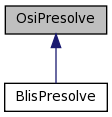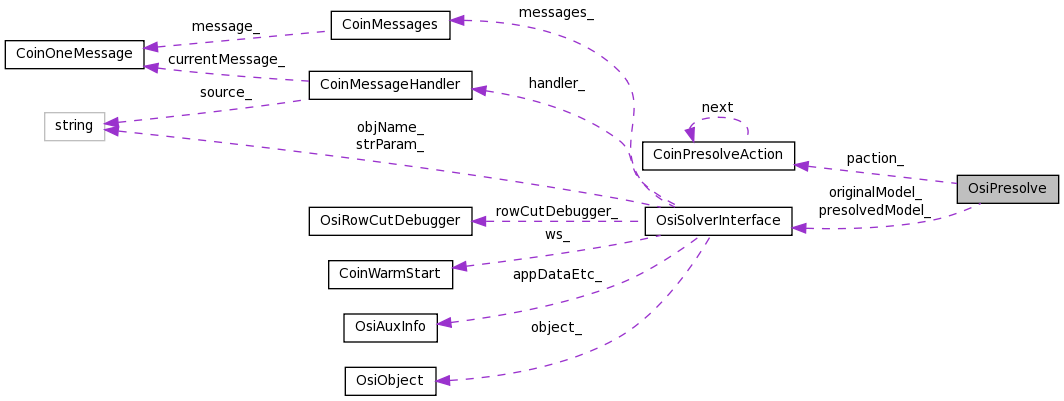OsiPresolve Class Reference
OSI interface to COIN problem simplification capabilities. More...
#include <OsiPresolve.hpp>


Public Member Functions | |
| OsiPresolve () | |
| Default constructor (empty object). | |
| virtual | ~OsiPresolve () |
| Virtual destructor. | |
| virtual OsiSolverInterface * | presolvedModel (OsiSolverInterface &origModel, double feasibilityTolerance=0.0, bool keepIntegers=true, int numberPasses=5, const char *prohibited=NULL, bool doStatus=true) |
| Create a new OsiSolverInterface loaded with the presolved problem. | |
| virtual void | postsolve (bool updateStatus=true) |
| Restate the solution to the presolved problem in terms of the original problem and load it into the original model. | |
| OsiSolverInterface * | model () const |
| Return a pointer to the presolved model. | |
| OsiSolverInterface * | originalModel () const |
| Return a pointer to the original model. | |
| void | setOriginalModel (OsiSolverInterface *model) |
| Set the pointer to the original model. | |
| const int * | originalColumns () const |
| Return a pointer to the original columns. | |
| const int * | originalRows () const |
| Return a pointer to the original rows. | |
| void | setNonLinearValue (double value) |
| "Magic" number. | |
| double | nonLinearValue () const |
| void | setPresolveActions (int action) |
| Whether we want to skip dual part of presolve etc. | |
Protected Member Functions | |
| virtual const CoinPresolveAction * | presolve (CoinPresolveMatrix *prob) |
| Apply presolve transformations to the problem. | |
| virtual void | postsolve (CoinPostsolveMatrix &prob) |
| Reverse presolve transformations to recover the solution to the original problem. | |
| void | gutsOfDestroy () |
| Destroys queued postsolve actions. | |
Private Attributes | |
| OsiSolverInterface * | originalModel_ |
| OsiSolverInterface * | presolvedModel_ |
| double | nonLinearValue_ |
| int * | originalColumn_ |
| Original column numbers. | |
| int * | originalRow_ |
| Original row numbers. | |
| const CoinPresolveAction * | paction_ |
| The list of transformations applied. | |
| int | ncols_ |
| Number of columns in original model. | |
| int | nrows_ |
| Number of rows in original model. | |
| CoinBigIndex | nelems_ |
| Number of nonzero matrix coefficients in the original model. | |
| int | presolveActions_ |
| Whether we want to skip dual part of presolve etc. | |
| int | numberPasses_ |
| Number of major passes. | |
Detailed Description
OSI interface to COIN problem simplification capabilities.
COIN provides a number of classes which implement problem simplfication algorithms (CoinPresolveAction, CoinPrePostSolveMatrix, and derived classes). The model of operation is as follows:
- Create a copy of the original problem.
- Subject the copy to a series of transformations (the presolve methods) to produce a presolved model. Each transformation is also expected to provide a method to reverse the transformation (the postsolve method). The postsolve methods are collected in a linked list; the postsolve method for the final presolve transformation is at the head of the list.
- Hand the presolved problem to the solver for optimization.
- Apply the collected postsolve methods to the presolved problem and solution, restating the solution in terms of the original problem.
The COIN presolve algorithms are unaware of OSI. The OsiPresolve class takes care of the interface. Given an OsiSolverInterface origModel, it will take care of creating a clone properly loaded with the presolved problem and ready for optimization. After optimization, it will apply postsolve transformations and load the result back into origModel.
Assuming a problem has been loaded into an OsiSolverInterface origModel, a bare-bones application looks like this:
OsiPresolve pinfo ; OsiSolverInterface *presolvedModel ; // Return an OsiSolverInterface loaded with the presolved problem. presolvedModel = pinfo.presolvedModel(*origModel,1.0e-8,false,numberPasses) ; presolvedModel->initialSolve() ; // Restate the solution and load it back into origModel. pinfo.postsolve(true) ; delete presolvedModel ;
Definition at line 61 of file OsiPresolve.hpp.
Constructor & Destructor Documentation
| OsiPresolve::OsiPresolve | ( | ) |
Default constructor (empty object).
| virtual OsiPresolve::~OsiPresolve | ( | ) | [virtual] |
Virtual destructor.
Member Function Documentation
| virtual OsiSolverInterface* OsiPresolve::presolvedModel | ( | OsiSolverInterface & | origModel, | |
| double | feasibilityTolerance = 0.0, |
|||
| bool | keepIntegers = true, |
|||
| int | numberPasses = 5, |
|||
| const char * | prohibited = NULL, |
|||
| bool | doStatus = true | |||
| ) | [virtual] |
Create a new OsiSolverInterface loaded with the presolved problem.
This method implements the first two steps described in the class documentation. It clones origModel and applies presolve transformations, storing the resulting list of postsolve transformations. It returns a pointer to a new OsiSolverInterface loaded with the presolved problem, or NULL if the problem is infeasible or unbounded. If keepIntegers is true then bounds may be tightened in the original. Bounds will be moved by up to feasibilityTolerance to try and stay feasible. When doStatus is true, the current solution will be transformed to match the presolved model.
This should be paired with postsolve(). It is up to the client to destroy the returned OsiSolverInterface, after calling postsolve().
This method is virtual. Override this method if you need to customize the steps of creating a model to apply presolve transformations.
In some sense, a wrapper for presolve(CoinPresolveMatrix*).
| virtual void OsiPresolve::postsolve | ( | bool | updateStatus = true |
) | [virtual] |
Restate the solution to the presolved problem in terms of the original problem and load it into the original model.
postsolve() restates the solution in terms of the original problem and updates the original OsiSolverInterface supplied to presolvedModel(). If the problem has not been solved to optimality, there are no guarantees. If you are using an algorithm like simplex that has a concept of a basic solution, then set updateStatus
The advantage of going back to the original problem is that it will be exactly as it was, i.e., 0.0 will not become 1.0e-19.
Note that if you modified the original problem after presolving, then you must ``undo'' these modifications before calling postsolve().
In some sense, a wrapper for postsolve(CoinPostsolveMatrix&).
| OsiSolverInterface* OsiPresolve::model | ( | ) | const |
Return a pointer to the presolved model.
| OsiSolverInterface* OsiPresolve::originalModel | ( | ) | const |
Return a pointer to the original model.
| void OsiPresolve::setOriginalModel | ( | OsiSolverInterface * | model | ) |
Set the pointer to the original model.
| const int* OsiPresolve::originalColumns | ( | ) | const |
Return a pointer to the original columns.
| const int* OsiPresolve::originalRows | ( | ) | const |
Return a pointer to the original rows.
| void OsiPresolve::setNonLinearValue | ( | double | value | ) | [inline] |
"Magic" number.
If this is non-zero then any elements with this value may change and so presolve is very limited in what can be done to the row and column. This is for non-linear problems.
Definition at line 134 of file OsiPresolve.hpp.
| double OsiPresolve::nonLinearValue | ( | ) | const [inline] |
Definition at line 136 of file OsiPresolve.hpp.
| void OsiPresolve::setPresolveActions | ( | int | action | ) | [inline] |
Whether we want to skip dual part of presolve etc.
1 bit allows duplicate column processing on integer columns and dual stuff on integers 2 bit set switches off actions which can change +1 to something else 4 bit set transfers costs to integer variables 8 bit set stops x+y+z=1 transform
Definition at line 145 of file OsiPresolve.hpp.
| virtual const CoinPresolveAction* OsiPresolve::presolve | ( | CoinPresolveMatrix * | prob | ) | [protected, virtual] |
Apply presolve transformations to the problem.
Handles the core activity of applying presolve transformations.
If you want to apply the individual presolve routines differently, or perhaps add your own to the mix, define a derived class and override this method
| virtual void OsiPresolve::postsolve | ( | CoinPostsolveMatrix & | prob | ) | [protected, virtual] |
Reverse presolve transformations to recover the solution to the original problem.
Handles the core activity of applying postsolve transformations.
Postsolving is pretty generic; just apply the transformations in reverse order. You will probably only be interested in overriding this method if you want to add code to test for consistency while debugging new presolve techniques.
| void OsiPresolve::gutsOfDestroy | ( | ) | [protected] |
Destroys queued postsolve actions.
E.g., when presolve() determines the problem is infeasible, so that it will not be necessary to actually solve the presolved problem and convert the result back to the original problem.
Member Data Documentation
OsiSolverInterface* OsiPresolve::originalModel_ [private] |
Original model (solver interface loaded with the original problem).
Must not be destroyed until after postsolve().
Definition at line 153 of file OsiPresolve.hpp.
OsiSolverInterface* OsiPresolve::presolvedModel_ [private] |
Presolved model (solver interface loaded with the presolved problem)
Must be destroyed by the client (using delete) after postsolve().
Definition at line 159 of file OsiPresolve.hpp.
double OsiPresolve::nonLinearValue_ [private] |
"Magic" number. If this is non-zero then any elements with this value may change and so presolve is very limited in what can be done to the row and column. This is for non-linear problems. One could also allow for cases where sign of coefficient is known.
Definition at line 166 of file OsiPresolve.hpp.
int* OsiPresolve::originalColumn_ [private] |
Original column numbers.
Definition at line 169 of file OsiPresolve.hpp.
int* OsiPresolve::originalRow_ [private] |
Original row numbers.
Definition at line 172 of file OsiPresolve.hpp.
const CoinPresolveAction* OsiPresolve::paction_ [private] |
The list of transformations applied.
Definition at line 175 of file OsiPresolve.hpp.
int OsiPresolve::ncols_ [private] |
Number of columns in original model.
The problem will expand back to its former size as postsolve transformations are applied. It is efficient to allocate data structures for the final size of the problem rather than expand them as needed.
Definition at line 183 of file OsiPresolve.hpp.
int OsiPresolve::nrows_ [private] |
Number of rows in original model.
Definition at line 186 of file OsiPresolve.hpp.
CoinBigIndex OsiPresolve::nelems_ [private] |
Number of nonzero matrix coefficients in the original model.
Definition at line 189 of file OsiPresolve.hpp.
int OsiPresolve::presolveActions_ [private] |
Whether we want to skip dual part of presolve etc.
1 bit allows duplicate column processing on integer columns and dual stuff on integers 4 transfers costs to integer variables
Definition at line 196 of file OsiPresolve.hpp.
int OsiPresolve::numberPasses_ [private] |
Number of major passes.
Definition at line 198 of file OsiPresolve.hpp.
The documentation for this class was generated from the following file:
- /home/coin/svn-release/OptimizationSuite-1.1.0/Osi/src/OsiPresolve.hpp
 1.6.1
1.6.1